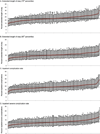Extended length of stay after surgery: complications, inefficient practice, or sick patients?
- PMID: 25074418
- PMCID: PMC4245077
- DOI: 10.1001/jamasurg.2014.629
Extended length of stay after surgery: complications, inefficient practice, or sick patients?
Abstract
Importance: With the health policy focus on shifting risk to hospitals and physicians, hospital leaders are increasing efforts to reduce excessive resource use, such as patients with extended length of stay (LOS) after surgery. However, the degree to which extended LOS represents complications, patient illness, or inefficient practice style is unclear.
Objective: To examine the influence of complications on the variance in hospitals' extended LOS rates after colorectal resections.
Design, setting, and participants: In this retrospective cohort study performed from January 1 through December 31, 2009, we analyzed data from the 2009 American College of Surgeons National Surgical Quality Improvement Program. Study participants were 22 664 adults undergoing colorectal resections in 199 hospitals.
Exposures: Inpatient complications recorded in the American College of Surgeons National Surgical Quality Improvement Program registry. Inpatient complications were identified by the association of the complication's postoperative date with the patient's surgical discharge date.
Main outcome and measure: Hospitals' risk-adjusted extended LOS rates, defined as the proportion of patients with a hospital stay greater than the 75th percentile for the entire cohort.
Results: A total of 2177 patients (42.8%) with extended LOSs did not have a documented inpatient complication. Although there was wide variation in risk-adjusted extended LOS (14.5%-35.3%) and risk-adjusted inpatient complication (12.1%-28.5%) rates, there was only a weak correlation (Spearman ρ = 0.56, P < .001) between the two. Only 52.0% of the variation in hospitals' extended LOS rates was attributable to hospitals' inpatient complication rates.
Conclusions and relevance: Much of the variation in hospitals' risk-adjusted extended LOS rates is not attributable to patient illness or complications and therefore most likely represents differences in practice style. Efforts to reduce excess resource use should focus on efficiency of care, such as increased adoption of enhanced recovery pathways.
Conflict of interest statement
Conflicts of Interest: Justin B. Dimick has a financial interest in ArborMetrix, Inc., which had no role in the study. Robert W Krell received a payment from Blue Cross/Blue Shield of Michigan for data entry, unrelated to the submitted work. Micah E Girotti has no conflicts of interest to disclose. The American College of Surgeons National Surgical Quality Improvement Program and the hospitals participating in the ACS-NSQIP are the source of the original data and cannot verify or be held responsible for the statistical validity of the data analysis or the conclusions derived by the authors.
Figures


References
-
- Lindenauer PK, Remus D, Roman S, et al. Public reporting and pay for performance in hospital quality improvement. N Engl J Med. 2007;356(5):486–496. - PubMed
-
- Robinowitz DL, Dudley RA. Public reporting of provider performance: Can its impact be made greater? Annu Rev Public Health. 2006;27:517–536. - PubMed
-
- Rosenthal MB, Landon BE, Normand SL, Frank RG, Epstein AM. Pay for performance in commercial HMOs. N Engl J Med. 2006;355(18):1895–1902. - PubMed
-
- Welch WP. Bundled medicare payment for acute and postacute care. Health Aff (Millwood) 1998;17(6):69–81. - PubMed
Publication types
MeSH terms
Grants and funding
LinkOut - more resources
Full Text Sources
Other Literature Sources
Medical

